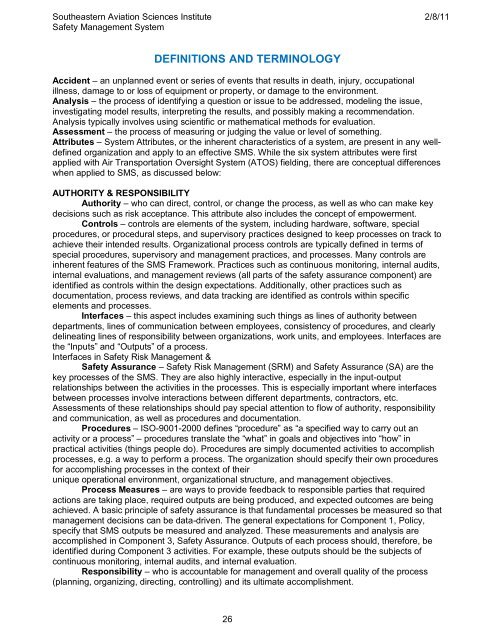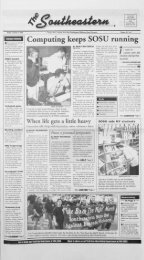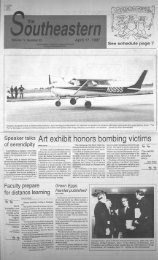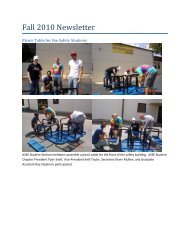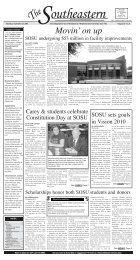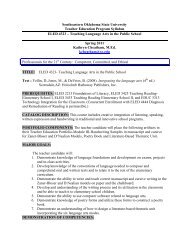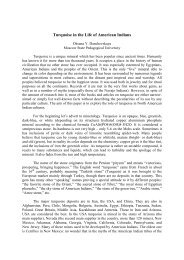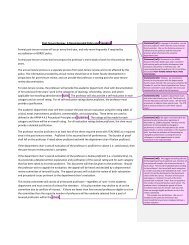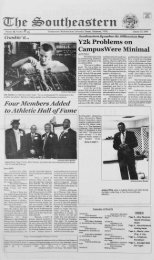Southeastern Aviation Safety Management System
Southeastern Aviation Safety Management System
Southeastern Aviation Safety Management System
You also want an ePaper? Increase the reach of your titles
YUMPU automatically turns print PDFs into web optimized ePapers that Google loves.
<strong>Southeastern</strong> <strong>Aviation</strong> Sciences Institute 2/8/11<br />
<strong>Safety</strong> <strong>Management</strong> <strong>System</strong><br />
DEFINITIONS AND TERMINOLOGY<br />
Accident – an unplanned event or series of events that results in death, injury, occupational<br />
illness, damage to or loss of equipment or property, or damage to the environment.<br />
Analysis – the process of identifying a question or issue to be addressed, modeling the issue,<br />
investigating model results, interpreting the results, and possibly making a recommendation.<br />
Analysis typically involves using scientific or mathematical methods for evaluation.<br />
Assessment – the process of measuring or judging the value or level of something.<br />
Attributes – <strong>System</strong> Attributes, or the inherent characteristics of a system, are present in any welldefined<br />
organization and apply to an effective SMS. While the six system attributes were first<br />
applied with Air Transportation Oversight <strong>System</strong> (ATOS) fielding, there are conceptual differences<br />
when applied to SMS, as discussed below:<br />
AUTHORITY & RESPONSIBILITY<br />
Authority – who can direct, control, or change the process, as well as who can make key<br />
decisions such as risk acceptance. This attribute also includes the concept of empowerment.<br />
Controls – controls are elements of the system, including hardware, software, special<br />
procedures, or procedural steps, and supervisory practices designed to keep processes on track to<br />
achieve their intended results. Organizational process controls are typically defined in terms of<br />
special procedures, supervisory and management practices, and processes. Many controls are<br />
inherent features of the SMS Framework. Practices such as continuous monitoring, internal audits,<br />
internal evaluations, and management reviews (all parts of the safety assurance component) are<br />
identified as controls within the design expectations. Additionally, other practices such as<br />
documentation, process reviews, and data tracking are identified as controls within specific<br />
elements and processes.<br />
Interfaces – this aspect includes examining such things as lines of authority between<br />
departments, lines of communication between employees, consistency of procedures, and clearly<br />
delineating lines of responsibility between organizations, work units, and employees. Interfaces are<br />
the “Inputs” and “Outputs” of a process.<br />
Interfaces in <strong>Safety</strong> Risk <strong>Management</strong> &<br />
<strong>Safety</strong> Assurance – <strong>Safety</strong> Risk <strong>Management</strong> (SRM) and <strong>Safety</strong> Assurance (SA) are the<br />
key processes of the SMS. They are also highly interactive, especially in the input-output<br />
relationships between the activities in the processes. This is especially important where interfaces<br />
between processes involve interactions between different departments, contractors, etc.<br />
Assessments of these relationships should pay special attention to flow of authority, responsibility<br />
and communication, as well as procedures and documentation.<br />
Procedures – ISO-9001-2000 defines “procedure” as “a specified way to carry out an<br />
activity or a process” – procedures translate the “what” in goals and objectives into “how” in<br />
practical activities (things people do). Procedures are simply documented activities to accomplish<br />
processes, e.g. a way to perform a process. The organization should specify their own procedures<br />
for accomplishing processes in the context of their<br />
unique operational environment, organizational structure, and management objectives.<br />
Process Measures – are ways to provide feedback to responsible parties that required<br />
actions are taking place, required outputs are being produced, and expected outcomes are being<br />
achieved. A basic principle of safety assurance is that fundamental processes be measured so that<br />
management decisions can be data-driven. The general expectations for Component 1, Policy,<br />
specify that SMS outputs be measured and analyzed. These measurements and analysis are<br />
accomplished in Component 3, <strong>Safety</strong> Assurance. Outputs of each process should, therefore, be<br />
identified during Component 3 activities. For example, these outputs should be the subjects of<br />
continuous monitoring, internal audits, and internal evaluation.<br />
Responsibility – who is accountable for management and overall quality of the process<br />
(planning, organizing, directing, controlling) and its ultimate accomplishment.<br />
26


